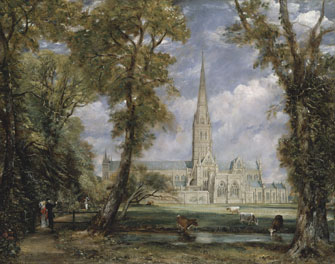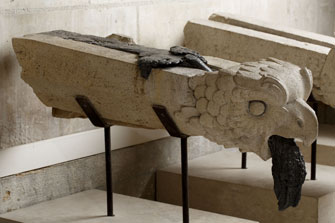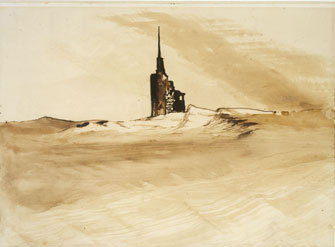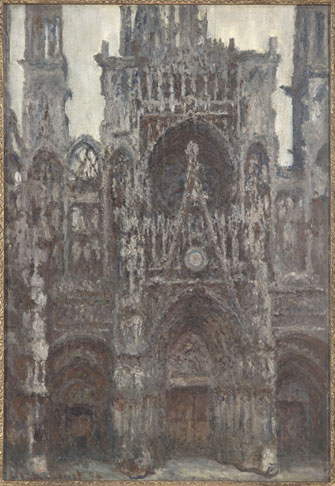Shedding New Light on
The Gothic Style

“Salisbury Cathedral from the Bishop’s Grounds” (c. 1825), by John Constable. © The Metropolitain Museum of Art. Dist. RMN Grand Palais
“Cathedrals 1789-1914: A Modern Myth,” the ambitious new exhibition at the Musée des Beaux Arts in Rouen, is less about cathedrals per se than it is about the revival in the 18th![]() and 19th century of interest in all things Gothic, a style that was not only abandoned and forgotten for centuries but also reviled as an uncouth remnant of the Dark Ages. Its very name, attributed to it during the Renaissance, implies disrespect, referring as it does to the Goths, the “barbaric” Germanic tribes who periodically invaded the Roman Empire during the Middle Ages.
and 19th century of interest in all things Gothic, a style that was not only abandoned and forgotten for centuries but also reviled as an uncouth remnant of the Dark Ages. Its very name, attributed to it during the Renaissance, implies disrespect, referring as it does to the Goths, the “barbaric” Germanic tribes who periodically invaded the Roman Empire during the Middle Ages.
All that changed beginning in the late 18th century, when the Romantics rediscovered Gothic architecture and writers like Goethe and Victor Hugo fostered a new appreciation of it among the public, Goethe through Faust and other works and Hugo through, of course, The Hunchback of Notre Dame, which turned Paris’s cathedral into a symbolic haven for the outcasts of the world.
The exhibition starts and ends with the violent destruction of cathedrals. During the Revolution, French cathedrals were attacked as symbols of both royal and religious power. The statues of the Kings of Israel in Notre Dame – mistakenly taken for French kings – lost their heads while the real royal family and the victims of the Terror were losing theirs. A little over a century later, in the early days of World War I, the Reims Cathedral, where the country’s kings had been crowned for centuries and thus a potent emblem of French royal power, was devastatingly bombed by the Germans, as shown in a film near the end of the show. One of the most telling objects in this part of the exhibition is an actual remnant of

Gargoyle from Reims Cathedral. Palais de Tau. © David Bordes/Centre des Monuments Nationaux the cathedral, one of its gargoyles, through the mouth of which pours now-solidified lead melted by the great heat of the fire rather than the rainwater it was designed for.
In between, we are treated to an exhaustive look at interpretations and celebrations of the Gothic style in the 19th century, with some 300 works of art and objects.
While France was the cradle of Gothic architecture, the exhibition gives nearly equal time to the two other countries where it flourished: Germany (the Wallraf-Richart Museum in Cologne collaborated on the exhibition, which will open there on September 26) and Britain.
From Britain comes a major painting by John Constable, “Salisbury Cathedral from the Bishop’s Ground” (c. 1825; pictured above), with the cathedral seen not from across the plain as it is in most views, but framed by tall trees that almost dwarf it, as if giving precedence to nature over the works of man (Camille Corot also shows a cathedral, at Mantes, through the trees in two lovely paintings dating from the early 1860s). Joseph Mallord William Turner weighs in with a series of detailed watercolor studies of light streaming through Salisbury Cathedral.
Victor Hugo gets a special section just to himself, with caricatures of him as “Cathedral Man,” sitting on top of Notre Dame being crowned in Reims Cathedral, or pointing at Notre Dame, whose towers form the H of his last name. More poetic are his own gracefully

“Le clocher dans la dune,” by Victor Hugo. © Maisons de Victor Hugo/Roger-Viollet
spare ink drawings of cathedrals.
Among a number of lovely works from the Impressionist period are – most fittingly – five

“Rouen Cathedral: The Portal, Front View” (1892), by Claude Monet. © Musée d’Orsay. Dist. RMN-Grand Palais/Patrice Schmidtof Claude Monet’s famous renderings of Rouen Cathedral at various times of days and in differing light and weather conditions.
The influence of Gothic architecture on the decorative arts is the subject of another room, with examples of everything from furniture to musical instruments, bookbinding, leather goods, ceramics and jewelry.
The show ends with a few post-World War I works on the theme of the cathedral by modern artists, among them Picasso, Matisse and Alfred Marquet. Nicolas de Staël’s haunting painting “La Cathédrale” (1951), all blacks, whites and grays, is an anomaly from this master of color.
The exhibition merits a trip to Rouen, only a little more than an hour from Paris, as does the museum itself, which is home to one of France’s finest collections and includes works by such artists as Rubens, Caravaggio, Velàzquez, Vouet, Poussin, Fragonard, Delacroix, Corot, Degas and Monet.
And, of course, a visit to Rouen Cathedral, a short walk from the museum, is de rigueur, preferably after seeing the exhibition, which will shed a whole new light on it.
Musée des Beaux-Arts de Rouen: Esplanade Marcel-Duchamp, 76000 Rouen. Tel.: 02 35 71 28 40. Open Wednesday-Monday, 10am-6pm. Closed Tuesday. Admission: €5. Through August 31, 2014. mbarouen.fr
Reader reaction: Click here to respond to this article (your response may be published on this page and is subject to editing).
Please support Paris Update by ordering books from Paris Update’s Amazon store at no extra cost. Click on your preferred Amazon location: U.K., France, U.S.
More reviews of Paris art shows.
© 2014 Paris Update
Favorite